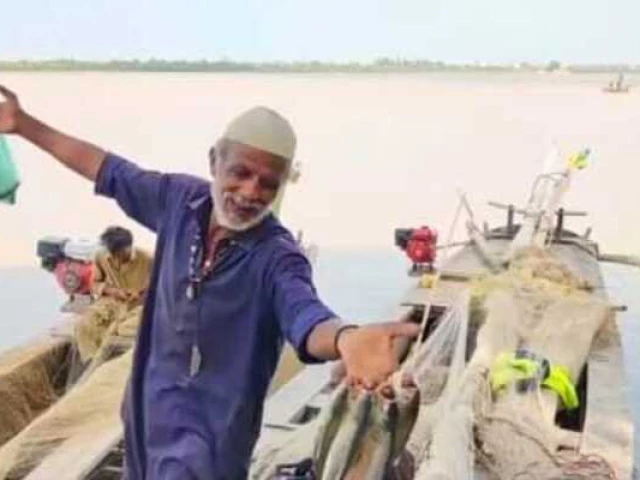Over the past two months, catastrophic floods have displaced millions over Pakistan and claimed thousands of lives. Fields, houses and infrastructure were destroyed on a large scale, causing damage worth billions of rupees. After creating historical destruction in Khyber-Pakhtunkhwa, Gilgit-Baltistan and Punjab, Floodwater’s Indus River Delta reached.
Unlike other parts of the country, the inhabitants of the Sindh Delta are not only fond of this water, but welcomes it. Farmers in Thatta, like Nadir Ali, who gladly celebrated the arrival of the flood water by performing a traditional Sindhi dance on a boat, says: “If the delta continues to receive water, we can grow premium red rice again”.
According to Adam Gandhro, head of the Sindh Fishermen Forum, the absence of river water in the last 15 years had the sea devoured land. More than a hundred villages were wiped out and forced people to migrate. Journalist Nizakat Shah reports that the sea in the last 30 years turned off 2.2 million acres of land from Karachi to Badin. Currently, the sea is grabbing one hectare of land daily, while about 30 hectares of land are affected by salinity every day.
The Fishermen’s Joy
The recent wave of fresh water has pushed the sea back. Fishermen return to their villages because after years they can catch palla fish again. “Our true festival is the day when fresh water reaches the delta,” Dhani Bakhsh shared.
Revival of forests and livelihoods
Gandhro states that if 450,000 cuses of water flows into the delta, the Mangrove and Timber Forest will be fully nourished. “After the water agreement in 1991, the delta has not received its proper proportion of water and shrunk the forest from 600,000 hectares to only 300,000. Now there is hope that these forests will thrive again,” added Aslam Mir Bah.
The drought and the sea penetration had deprived not only fishermen, but also woodcuts to their livelihood. Now people like Muhammad Bakhsh return to the timber trade.
Influence on health and the environment
Salinity in underground water had caused serious health problems. “The use of saline increased cases of kidney disease, bone weakness and abortions among pregnant women,” said social activist Humeira Ali.
The return of fresh water will not only improve agriculture, but also attracts wandering birds that had left the region due to the sea ingredient.
Festivities of joy
With the arrival of fresh water, the Delta community hosts Palla fishing parties and congratulates each other. For them, this water brings life, prosperity and hope for the future.
Read: Indus -Delta’s situation
For fishermen living with Sindh’s coast, ups and downs in life are conditioned by the quality and amount of river water flowing into their area. Recently, however, the flow of Indus against these areas has been significantly reduced, allowing seawater to seep in and destroy the lands and livelihoods of fishing families.
Yasmeen Shah, the central leader of the Pakistan Fishers forum, revealed that the erosion of land in the coastal areas of Sindh was first reported in 1950. “So far, about 3.5 million hectares of land has already been lost to the sea. There was a wandering to Karach and like others have been to migrate.
“Due to the Sindh government’s policy, the contracting system in the fishing sector has been strengthened, which has affected the employment of poor fishermen. On the other hand, no agreement on social security for fishermen has been made at government level,” Shah added. With reference to the federal government’s new fisheries policy, Shah stated that it would further threaten the employment of fishermen by protecting the large companies that seek to thrive in the fishing sector.
According to Naseer Memon, an expert on disaster management and resettlement, before the construction of the Tarbela dam, about 300,000 CUSCS WATER used to reach the Kutcha area in Sindh every year, an amount reaching 500,000 CUSSCS every three to four years.
“Some experts believe that in 2022, a large amount of water flowed down from the Kotri Barrage into the sea, which could have been saved by building a dam on the Indus River. Although that water was not river water, a large amount of it had accumulated in the lower areas of Sindh due to the Breakdown of Manchar Lake.
Read more: Death of a Delta: Pakistan’s Indus sinks and shrinks
MEMON further informed that after the Kotri barrier, the Indus River must travel 300 miles to reach the sea. “On the route of the river there are three districts in Sindh, Thatatta, Sajawal and Badin, who are home to two million people. Did they not need water? In such a situation, the construction of new canals would mean to deprive millions of people living in the lower mind of drinking water,” Memon emphasized.
“Global experts claim that at least 5,000 CUSSCS is needed water daily or 25 million hectares of five years under Kotri to save the Indus-Delta ecosystem. Apart from the monsoon months, this amount of water never passes under Kotri because there is continuous seawater.
Fatima Majeed, newly elected President of Fishermen Cooperative Society for The Welfare of Fishermen, told Express Pakinomist That the fishing community had had problems for a long time. “Increasing fishermen’s employment opportunities and launching their welfare projects will be our highest priority. We will also try to increase exports of fish so that more employment opportunities could be given to the fishermen,” Majeed said.
Express Pakinomist Tried to contact Director -General Fisheries Sindh Siraj Ahmed Solangi to ask about the steps the Sindh government has taken to protect the rights of fishermen, but despite waiting for a long time, no response was received from him.



